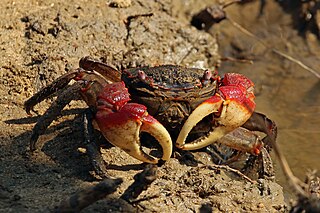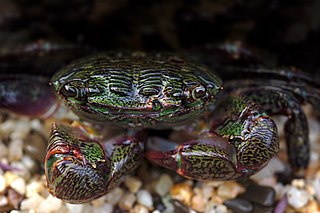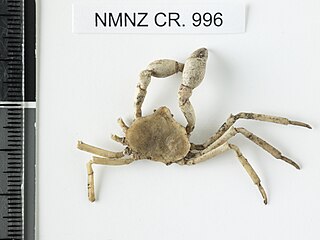
The fiddler crab or calling crab may be any of more than one hundred species of semiterrestrial marine crabs in the family Ocypodidae, well known for their sexually dimorphic claws; the males' major claw is much larger than the minor claw, while the females' claws are both the same size. A smaller number of ghost crab and mangrove crab species are also found in the family Ocypodidae. This entire group is composed of small crabs, the largest being slightly over two inches (5 cm) across. Fiddler crabs are found along sea beaches and brackish intertidal mud flats, lagoons, swamps, and various other types of brackish or salt-water wetlands.

Mangrove crabs are crabs that live in and around mangroves. They belong to many different species and families and have been shown to be ecologically significant by burying and consuming leaf litter. Mangrove crabs have a variety of phylogenies because mangrove crab is an umbrella term that encompasses many species of crabs. Two of the most common families are sesarmid and fiddler crabs. They are omnivorous and are predated on by a variety of mammals and fish. They are distributed widely throughout the globe on coasts where mangroves are located. Mangrove crabs have wide variety of ecological and biogeochemical impacts due to the biofilms that live in symbiosis with them as well as their burrowing habits. Like many other crustaceans, they are also a human food source and have been impacted by humans as well as climate change.

Perisesarma is a genus of mangrove crabs in the family Sesarmidae predominantly found in the Indo-Pacific. Some 23 species are described as of late 2006, with two from West Africa: P. kammermani(De Man, 1883) and P. albertiRathbun, 1921. They are typically small, semiterrestrial crabs found on the forest floor at low tide. They eat nearly anything they can, and try to eat anything that does not threaten them — including pencils and other objects dropped on the forest floor. The last species of the genus described is P. samawatiGillikin and Schubart (2004). It can be found in East Africa along with P. guttatum, but its sister species is P. eumolpe from Malaysian mangroves.

The Sesarmidae are a family of crabs, previously included in the Grapsidae by many authors. Several species, namely in Geosesarma, Metopaulias, and Sesarma, are true terrestrial crabs. They do not need to return to the sea even for breeding.

The Varunidae are a family of thoracotrematan crabs. The delimitation of this family, part of the taxonomically confusing Grapsoidea, is undergoing revision. For a long time, they were placed at the rank of subfamily in the Grapsidae, but they appear to be closest to Macropthalmus and the Mictyridae, which are usually placed in the Ocypodoidea. It may thus be better to merge the latter superfamily with the Grapsoidea, retaining the latter name as it is older.

Percnon gibbesi is a species of crab. It is one of at least two species commonly called Sally Lightfoot, and is also referred to as the nimble spray crab or urchin crab. It has been described as "the most invasive decapod species to enter the Mediterranean".

Aratus pisonii, commonly known as the mangrove tree crab, is a species of crab which lives in mangrove trees in tropical and subtropical parts of the Americas, from Florida to Brazil on the Atlantic coast. A.pacificus occurs from Nicaragua to Peru on the Pacific coast. A. pisoni feeds mostly on the leaves of the mangroves, but is an omnivore, and prefers animal matter when possible. A. pisonii and A. pacificus are the two species in the genus Aratus. The specific epithet pisonii commemorates the Dutch naturalist Willem Piso who travelled in Brazil in 1638 with Georg Marggraf.

Heloecius cordiformis is a species of semiterrestrial crab found in mangrove swamps and mudflats along the east coast of Australia. Adults are around 25 mm (1 in) wide, with males being larger and having larger and more conspicuously coloured claws. The males wave their claws to communicate with other crabs, giving them their common name of semaphore crab. They can breathe both in air and under water, and feed at low tide on detritus in the sediment. H. cordiformis is the only species in the genus Heloecius and the family Heloeciidae.

Pachygrapsus is a genus of small shore crabs. Recent genetic data suggest this genus to be possibly polyphyletic.

Hemigrapsus is a genus of varunid crabs comprising thirteen species native almost exclusively in the Pacific Ocean, but two have been introduced to the North Atlantic region.

Johngarthia lagostoma is a species of terrestrial crab that lives on Ascension Island and three other islands in the South Atlantic. It grows to a carapace width of 110 mm (4.3 in) on Ascension Island, where it is the largest native land animal. It exists in two distinct colour morphs, one yellow and one purple, with few intermediates. The yellow morph dominates on Ascension Island, while the purple morph is more frequent on Rocas Atoll. The species differs from other Johngarthia species by the form of the third maxilliped.

The Panopeidae are a family containing 26 genera of morphologically similar crabs, often known as "mud crabs". Their centers of diversity are the Atlantic Ocean and eastern Pacific Ocean.

Paraleptuca chlorophthalmus, is a common fiddler crab found in the mangroves of East Africa, from Somalia to South Africa, as well as Madagascar and Mauritius. Marsh fiddlers dig burrows in the muddy or sandy banks of salt marshes, which they use to protect themselves from predators, high tide and extreme temperatures. They feed by filtering detritus out of mud, and defend their burrows against other fiddler crabs. Paraleptuca chlorophthalmus is characterised by its red pereiopods and blue and black markings on its carapace.

Elamena is a genus of crab, containing the following species:

Parasesarma leptosoma, also known as the arboreal crab, is an arboreal, leaf-eating mangrove crab, from East and South Africa where it is found on Rhizophora mucronata and Bruguiera gymnorhiza, but not on Avicennia marina. It occupies an ecological niche similar to that of another sesarmid, Aratus pisonii, from the Americas.
The Red-claw mangrove crab is a crab species in the genus Parasesarma and the family Sesarmidae. It is distributed in coastal brackish water habitats of the western Indian Ocean.

The Micro Mangrove Crab (Haberma tingkok) is a species of micro-mangrove crab native to Hong Kong. It was first discovered by Stefano Cannicci from the University of Hong Kong and Peter Ng from the University of Singapore in the Ting Kok Mangrove forests in the northeast of Hong Kong and listed on the World Register of Marine Species (WoRMS) in April of 2017. It was the third species placed in the genus Haberma, which was discovered in 2002.

Austruca is a genus of indo-west Pacific fiddler crabs in the family Ocypodidae. There are about 13 described species in this genus.

Leptuca is a genus of fiddler crabs belonging to the family Ocypodidae.

Sesarmops is a genus of crabs in the family Sesarmidae. Its members are distributed through the Indo–West-Pacific oceanic region. They live in freshwater forest streams near the coast, and in mangroves.


















